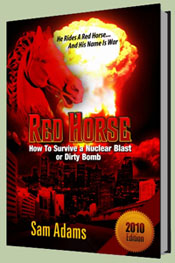 |
| © AFP/HO/DIGITAL GLOBE |
LOS ANGELES (AFP) – California is closely watching the crisis at a Japanese nuclear plant, but officials downplayed the threat that a radioactive cloud blown across the Pacific could pose for the US West Coast.
While radioactivity could reach the United States from the quake-hit Fukushima plant, the levels would not be high enough to cause major health problems, said the Nuclear Regulatory Commission (NRC).
Some experts disagreed, notably pointing to the west-east jet stream, but NRC — which was asked by Japan on Monday to send nuclear experts to deal with the crisis — said even the Pacific island state of Hawaii faced little risk.
“Right now it’s quite possible that there could be some radiation floating over the United States. But we don’t think that it would be particularly harmful… even in a worst case scenario,” spokesman David McIntyre told AFP.
“We see a very low likelihood, a very low probability that there is any possibility of harmful radiation levels in the United States or in Hawaii or in any other US territories,” added an NRC statement.
The comments came as Japanese authorities grappled with multiple crises at the Fukushima No. 1 plant, located 250 kilometers (155 miles) north of Tokyo, rocked by Saturday’s 8.9 quake and tsunami in northeastern Japan.
The plant has been rocked by two explosions, and early Tuesday officials said that fuel rods in the number two reactor were again “fully exposed”, boosting fears of an eventual partial meltdown.
California’s Department of Public Health says it is “monitoring the situation closely,” and highlights its Nuclear Emergency Response Program, which sets out measures to be taken in case of a nuclear incident.
But the document is clearly designed for a possible radioactive leak from one of California’s two nuclear plants — including due to a long-feared major earthquake here — rather than a threat from afar.
“Emergency preparedness is built around the concept of protecting populations around the plants because that’s where the danger is. The danger isn’t thousands of miles away,” said the NRC’s spokesman.
Japan is some 5,000 miles (8,000 kilometers) from the US West Coast, and nearer to Alaska in the north. Some experts suggest that, blown along by the fast-moving jet stream, radioactivity could reach north America in 36 hours.
 “The worst case scenario is .. the fuel rods fuse together, the temperatures get so hot that they melt together in a radioactive molten mass that bursts through the containment mechanisms, said nuclear expert Joe Cirincione.
“The worst case scenario is .. the fuel rods fuse together, the temperatures get so hot that they melt together in a radioactive molten mass that bursts through the containment mechanisms, said nuclear expert Joe Cirincione.
“Some of the radioactivity could carry in the atmosphere to the West Coast of the US,” added Cirincione, head of anti-nuclear group Ploughshares Fund.
He cited the 1986 Chernobyl nuclear disaster to underline how far radioactivity can travel.
“The radioactivity spread around the entire northern hemisphere,” from the devastated Ukrainian plant, he said.
Harvey Wasserman, a senior adviser to environmental group Greenpeace in the US added that after Chernobyl “fallout did hit the jet stream and then the coast of California, thousands of miles away, within ten days.
“It then carried all the way across the northern tier of the United States,” he said.
The NCR spokesman declined to comment in depth on possible scenarios for how quickly or at what levels radioactivity could reach the US mainland.
“Right now the government as a whole has people looking at the situation and asking these questions. We don’t have the answers yet. We don’t have anything that we can say publicly right now.”
“This is an unfolding situation and really we can’t comment on it very much,” he added, while stressing the NRC’s basic view that the threat to the US is minimal.
“If that changes, believe me, we would say so,” he added.
© AFP — Published at Activist Post with license
RELATED ARTICLE:
Potassium Iodide Works: Rare Agreement Between Alternative Health and the FDA

Be the first to comment on "US West Coast: on frontline from nuclear cloud?"